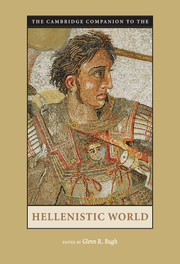Refine search
Actions for selected content:
23990 results in Ancient history

The Cambridge Companion to the Hellenistic World
-
- Published online:
- 28 November 2007
- Print publication:
- 01 May 2006
References
-
- Book:
- Law and Crime in the Roman World
- Published online:
- 05 June 2012
- Print publication:
- 15 November 2007, pp 137-142
-
- Chapter
- Export citation
Index
-
- Book:
- Law and Crime in the Roman World
- Published online:
- 05 June 2012
- Print publication:
- 15 November 2007, pp 143-148
-
- Chapter
- Export citation
4 - The thief in the night
-
- Book:
- Law and Crime in the Roman World
- Published online:
- 05 June 2012
- Print publication:
- 15 November 2007, pp 43-58
-
- Chapter
- Export citation
1 - Competing discourses
-
- Book:
- Law and Crime in the Roman World
- Published online:
- 05 June 2012
- Print publication:
- 15 November 2007, pp 1-11
-
- Chapter
- Export citation
6 - Controlling elites II: maiestas
-
- Book:
- Law and Crime in the Roman World
- Published online:
- 05 June 2012
- Print publication:
- 15 November 2007, pp 72-85
-
- Chapter
- Export citation
Preface
-
- Book:
- Law and Crime in the Roman World
- Published online:
- 05 June 2012
- Print publication:
- 15 November 2007, pp ix-x
-
- Chapter
- Export citation
2 - Public process and the legal tradition
-
- Book:
- Law and Crime in the Roman World
- Published online:
- 05 June 2012
- Print publication:
- 15 November 2007, pp 12-27
-
- Chapter
- Export citation
9 - Representations of murder
-
- Book:
- Law and Crime in the Roman World
- Published online:
- 05 June 2012
- Print publication:
- 15 November 2007, pp 118-132
-
- Chapter
- Export citation
Frontmatter
-
- Book:
- Law and Crime in the Roman World
- Published online:
- 05 June 2012
- Print publication:
- 15 November 2007, pp i-vi
-
- Chapter
- Export citation
8 - Remedies for violence
-
- Book:
- Law and Crime in the Roman World
- Published online:
- 05 June 2012
- Print publication:
- 15 November 2007, pp 106-117
-
- Chapter
- Export citation
7 - Sex and the City
-
- Book:
- Law and Crime in the Roman World
- Published online:
- 05 June 2012
- Print publication:
- 15 November 2007, pp 86-105
-
- Chapter
- Export citation
3 - Cognitio
-
- Book:
- Law and Crime in the Roman World
- Published online:
- 05 June 2012
- Print publication:
- 15 November 2007, pp 28-42
-
- Chapter
- Export citation
Bibliographical essay
-
- Book:
- Law and Crime in the Roman World
- Published online:
- 05 June 2012
- Print publication:
- 15 November 2007, pp 133-136
-
- Chapter
- Export citation
Contents
-
- Book:
- Law and Crime in the Roman World
- Published online:
- 05 June 2012
- Print publication:
- 15 November 2007, pp vii-viii
-
- Chapter
- Export citation
5 - Controlling elites I: ambitus and repetundae
-
- Book:
- Law and Crime in the Roman World
- Published online:
- 05 June 2012
- Print publication:
- 15 November 2007, pp 59-71
-
- Chapter
- Export citation
INDEX
-
- Book:
- The Conquests of Alexander the Great
- Published online:
- 05 June 2012
- Print publication:
- 05 November 2007, pp 205-218
-
- Chapter
- Export citation
1 - INTRODUCTION
-
- Book:
- The Conquests of Alexander the Great
- Published online:
- 05 June 2012
- Print publication:
- 05 November 2007, pp 1-4
-
- Chapter
- Export citation
6 - RESISTANCE ON TWO FRONTS
-
- Book:
- The Conquests of Alexander the Great
- Published online:
- 05 June 2012
- Print publication:
- 05 November 2007, pp 87-111
-
- Chapter
- Export citation
5 - CONQUEST OF THE ACHAEMENIDS
-
- Book:
- The Conquests of Alexander the Great
- Published online:
- 05 June 2012
- Print publication:
- 05 November 2007, pp 41-86
-
- Chapter
- Export citation
